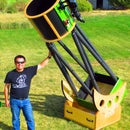Introduction: Polyhedral Dice Boxes
Since my youth I have been a tabletop gamer, but have always loved role-playing games the most. At the center of many games, role-playing games in particular, are dice. I've always been enthralled by the cerebral challenge of solving mysteries and completing epic quests, but all the while playing the risks through the intricate rolling of dice.
Polyhedral dice take the form of the classic Platonic solids -- a tetrahedron ("d4"), a cube ("d6"), an octahedron ("d8), a dodecahedron ("d12"), and an icosahedron ("d20"). Added to the mix is also a 10-sided die ("d10"), which together with another d10 can roll percentages ("d%"). Various games will require more or less of different types of these basic shapes, but a "standard" set in my world is 7 dice.
I've always carried them around in a traditional dice bag, but lately a variety of companies have started producing wooden dice boxes, finely crafted from exotic woods. This instructable documents an exercise to make my own wooden dice chests -- crafted boxes with individual wells to keep and protect sets of gaming dice.
Step 1: Motivation & Goals
My gaming life has always been full of dice. Like most gamers, I have "my set" (well, like most gamers I have several!) -- the constant companions that have journeyed with me on many, many adventures across magical worlds and galactic landscapes. Over the years, I've collected more than a few sets, because they look cool or because I like to use different dice for different games.
When I decided to try my hand at making my own dice chests, I set some rules:
- I didn't want to buy anything -- I wanted to start with wood in my scrap bin. I was actually inspired by a set of birch plywood rounds and ends of maple stock that were left over from when I built my telescope.
- I don't have a fancy CNC system -- my shop is more or less traditional. The fanciest piece of equipment I have is a drill press. The inspiration then for the instructable was to see what you could make with "simple tools."
Step 2: Materials
My materials list is as follows:
- scrap wood stock, matched pieces 3/4" thick
- small (~5/16" diameter) neodymium magnets
- paper patterns for drilling and artifying
- 1" Forstner bit
- craft foam sheets
- woodburner
- stain, polyurethane
(1) Wood -- I didn't start with a particular box design in mind. I first found pieces of wood suitable for the project, then designed around them. The boxes are two pieces that form each side of the dice box, so I was looking for pieces that were at least 3/4" thick. I found enough scrap pieces to make the 4 boxes shown here -- a good spectrum of sizes and shapes to play around with.
(2) Magnets -- I wanted the boxes to be securely shut without external mechanisms that protrude and catch on things. Neodymium magnets seem to be the thing (they are strong), but finding small ones proved difficult. However, my nametag at work has a magnetic back on it. Very often I lose my nametag (it usually hooks on something and gets knocked off without me noticing -- the life of an astronomer is rugged), but the magnetic back falls in my pocket. I always keep these and throw them in my materials box. A little work with two pairs of pliers yielded a nice supply of little magnets! You could probably find them in nametag sets at an office supply store.
Step 3: Wood Preparation
I matched the individual pieces of stock together for size. Because they were all the result of building matched pieces for my telescope, they were pretty closely matched in size. For the minor differences, I evened out the pieces by clamping the blocks together and running my router down the mismatched side using a laminate trimming bit. If there were a substantial difference, I would have had to use a more robust cutting bit.
Because this is wood from my scrap bin, it is less than perfect in some regards. There are some saw burns on the ends of some of the pieces of the maple stock, but I decided it didn't bother me so I didn't spend any time trying to get rid of them -- they would be "rustic." Also, some of the pieces have divots from mounting screws that had been used to hold the piece in place when I built the telescope. I filled these with wood filler.
I wanted the boxes to not have sharp corners on the top and bottom, so I used a 1/4" rounding bit on my router to take the top edges off each piece.
Step 4: Dice Well Patterns & Drilling
(1) Each of the pieces has a set of individual wells that the dice sit in. Because the boxes are two matched pieces (top and bottom), I had to make sure the wells on one side match the wells on the other side. I made paper patterns to help locate the wells. I laid the outline of each of the blocks out in Illustrator, and started playing around with patterns of 1" circles, until I found orientations that looked useful or cool. For the larger boxes I can have multiple dice sets, but in the smaller boxes only one.
Illustrator was useful for layout because I could use the alignment tools to get all the patterns of circles lined up. Make sure to mark the centers of the circles -- this is the location where you will have to drill the well, and you need to know where to set your bit down! The patterns also contain the locations to mark the spots for the magnetic closures.
(2) I laid the template over the block, and pushed a pin through the center dot of each well to mark its location. To mark the companion piece, I want the MIRROR image of the wells, so I flip the paper over, and use the pinholes as a guide to mark the second piece.
(3) The wells each need to be half the depth of a regular polyhedral die, with a bit of extra depth for a thickness of foam to pad the well. I set my drill press for 5/8" depth. The wells were each drilled using a 1-inch Forstner bit, which makes flat-bottomed holes. [Aside -- I had started with a slightly smaller bit after measuring my d20, but after testing it on a bit of scrap wood, I discovered the d4 needed a full 1" wide circle to fit.]
ADDED: Many people have asked for the drill pattern of the dice wells. I've added a PDF file with the patterns you see here.
Attachments
Step 5: Magnet Mounts
For the magnetic closure, I drilled 5/16" holes that were as deep as my magnets were tall.
These holes were just small enough that I could press fit the magnets in without having to glue them in somehow. I pressed the magnet in using a small block of wood to make sure I didn't press it too deep. The result is a magnet flush with the wood surface.
IMPORTANT: You want the magnets to latch to each other, so you have to put them in with the correct orientation! Place the magnets in ONE SIDE of your box. Then put the matching magnet on top of it. The neodymium magnets are quite strong and will correctly orient themselves. With a sharpie, color the back of the paired magnet, and pull it off. When you insert it in the other half of the box, make sure the side you marked is DOWN when you put it in the matching hole!
Step 6: Surface Art & Finishing
I had originally intended to do solder inlay on the boxes (using this instructable), but some initial exploration convinced me that I did not have the carving skills to make it work well. So I fell back on woodburning.
I found some nice patterns which I printed out on paper. I then transfered them to the cover of the boxes using the old "elementary school tracing trick" -- shade the back of the pattern page, lay it on the box pattern side up, and trace the outline of your pattern. The pressure of your trace will transfer the rubbing on the back to your box -- pattern transfered!
I was playing around with the woodburning tips -- I started with a cone point, but rapidly decided that I could do all my patterns (irrespective of the complexity) using a round flowpoint. I practiced a bit first before doing it on my boxes!
On the round dice box, there was a divot I had filled with wood filler; when I placed the pattern (a flying dragon) I cleverly chose it so the filled circle looked like a Moon.
I didn't have a strong feeling for whether or not to stain the boxes, so I used wipe-on stain in several different colors and left one unstained. All were then finished with a coat of clear gloss polyurethane.
Step 7: Lining the Dice Wells
I didn't want the dice to rattle around too much, so I lined the top and bottom of each of the wells with circles of hobby foam. I color coordinated the wells, particularly on the large multi-dice set boxes to help keep the orientations of the boxes correct so the right wells line up.
The foam circles were glued in using white glue.
Step 8: Last Thoughts
Overall I am very happy with how this first foray turned out! I'm particularly happy with how well the woodburning worked, though I would still like to try the solder inlay.
I'm not sure I like colored stains, but it does provide some interesting color appeal when the box is sitting on the table.
One thing I would change for next time: the boxes hold together with the magnets quite well, however it is easy to slide them apart. If you are carrying the box around in your backpack or bag, it is easy to knock the lid off, so I need to devise a small alignment peg that engages when the lid is on the box to mitigate sliding.
I hope you enjoyed this instructable and try your hand at making your own dice boxes!

Second Prize in the
Gaming Contest












